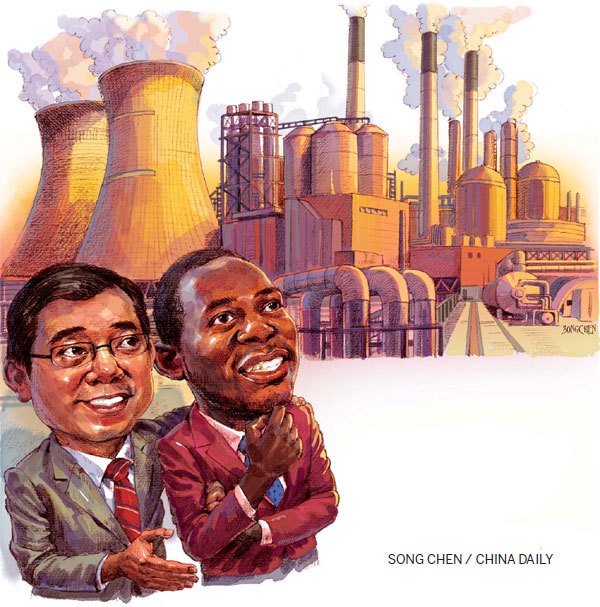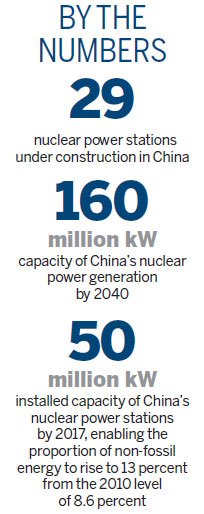

|
Dayawan Nuclear Power Station in Guangdong province. China will eventually need 200 nuclear power plants to meet demand, experts say. Xinhua |
|
The transmission lines of the Tianwan Nuclear Power Plant in Lianyungang, Jiangsu province. Geng Yuhe / for China Daily |
Chinese nuclear companies may use africa as springboard for its overseas nuclear business
Lower costs and pollution concerns main drivers for demand
Though there are still apprehensions over its future, Chinese nuclear firms are looking to make great strides in overseas markets such as Africa. Although most of the moves are at an early stage, they will gain traction in the next few years as African nations search for clean and safe energy solutions.
"The fear and panic associated with nuclear energy after the Fukushima disaster seem to have dissipated. Countries are now taking a more objective and rational approach toward nuclear energy," says Wang Yiren, vice-chairman of the China Atomic Energy Authority.
"Over the past four years, nuclear energy development across the world has experienced many twists and turns. But the situation has greatly changed. New nuclear power projects are coming up in US, Russia, France and China," Wang said in his remarks at the International Ministerial Conference on Nuclear Energy in the 21st Century, held in St Petersburg in June.
Some African nations such as South Africa have already started on their nuclear energy plans.
"South Africa has strong scientific and research capabilities regarding many nuclear-relevant technologies, which will get more impetus if it fast-tracks its nuclear power plans," says Zhao Yongkang, deputy director of the Nuclear Safety Management Department at the Ministry of Environmental Protection.
He says that the technologies used in China's largest nuclear fuel elements factory was imported from South Africa initially.
"South Africa also used to lead scientific research in pebble bed modular reactors, a frontier reactor type that is safer and smaller in size, which has attracted worldwide attention," Zhao says.
"But the country has encountered some financial problems when trying to commercialize this technique and so not much progress has been made."
Although the construction of a new pebble-bed modular reactor in South Africa was canceled in 2010, Zhao maintains the country still has the best credentials to develop nuclear power quickly.
Research-oriented nuclear reactors have also been tested in other African nations such as Kenya, Ghana and the Democratic Republic of the Congo. Uganda, Nigeria, Senegal and Niger have also expressed interest in nuclear energy, experts say.
Demand surge
Global electricity demand is expected to grow by about 85 percent or 16,000 terrawatt-hours (about four times the current usage in the US) before 2040. Much of this growth will be fueled by the industrial sector, followed by residential and commercial sectors, according to the Outlook for Energy: A View to 2040 report published by oil and gas firm Exxon Mobil. The report says that while energy consumption in China will increase substantially, it will also generate more clean energy, especially nuclear, during the same period.
Electricity generation from nuclear power worldwide is expected to increase from 2,620 billion kilowatt-hours in 2010 to 5,492 billion kWh in 2040, according to International Energy Outlook 2013, released by the US Energy Information Administration in July. The report says that European nations such as the United Kingdom, Poland, and Turkey are planning to generate more energy through nuclear power.
China plans to build 200 new nuclear power plants and speed up the construction of 29 more as part of its efforts to cut the high level of emissions generated by the large-scale use of coal.
"Demand for nuclear plants in China will reach 200, with four to six new projects being approved annually," says Jian Jingwen, deputy head of the equipment department at the State Nuclear Power Technology Corporation. There is expected to be 10 new plants every year after 2020.
China's nuclear power industry is also one of the fastest growing industries in the world and accounts for more than 14 percent of the nuclear power generated globally every year. Of the 64 nuclear reactors under construction worldwide, 29 are in China, Zhao from the Ministry of Environmental Protection, said in July.
Nuclear power generation capacity in China will rise from 10.7 million kilowatts in 2010 to 160 million kW by 2040. The nation will also account for more than 40 percent of the global net increase in nuclear capacity between 2010 and 2040, according to the International Energy Outlook 2013 report.
China now has 17 commercial nuclear power generating units, with an installed capacity of 14.74 million kW.
By 2017, the installed capacity of China's nuclear power plants will increase to 50 million kW. This, experts say, will help China meet its goal of cutting total coal consumption to below 65 percent of total primary energy use, and raise the share of non-fossil fuel energy to 13 percent from the 2010 level of 8.6 percent, as part of its comprehensive new plan to tackle air pollution.
According to industry sources, nuclear energy may see even more impetus in the next few years as other clean energy sources such as solar and wind face storage and transmission bottlenecks.
Nuclear power production around the world currently accounts for 15 percent of the gross generation of electricity, through a total of 437 nuclear power stations.
Despite the impressive numbers, misgivings about nuclear energy still persist.
Factors such as operational safety, waste disposal and public opinion need to be addressed thoroughly before proceeding with nuclear power projects, says Zhao from the Ministry of Environmental Protection.
Chen Xiaoqiu, deputy chief engineer of the ministry's Nuclear and Radiation Safety Center, says that China has used the most advanced technologies in its newly built and under-construction nuclear power stations.
"The core-damage frequency (a term used in risk assessment indicating the likelihood of an accident that could damage a nuclear reactor core) of the newly constructed units are less than 1x10-5, meaning that a core damage incident is likely to take place in no less than 100,000 reactor years," Chen says.
"The large release frequency, indicating the likelihood of an accident causing a massive discharge of radioactive materials into the environment, is less than 1x10-6 per reactor year, meaning one large release incident is likely to occur in at least 1 million reactor years."
The collective amount of radiation caused by the coal fuel chain, on the other hand is 50 times that caused by the nuclear fuel chain, says Pan Ziqiang, an academic at the Chinese Academy of Engineering and an expert on nuclear radiation prevention and control.
But these statistics do little to end public doubts over the use of nuclear energy.
|
Construction takes place at the No 4 unit of Tianwan Nuclear Power Plant. Wang Jianmin / for China Daily |
African moves
Chinese nuclear companies have already started making their presence felt in Africa. The state-owned China National Nuclear Corporation has been active in South Africa and is trying to aggressively market its experience developing nuclear power plants. It currently has nine operational reactors and 12 under construction at five new nuclear power plants in Africa.
The State Nuclear Power Technology Corporation is another Chinese company that is actively looking to the South African market for expansion. It is banking on its past experience with Westinghouse Electric of the US to bring in orders.
China Guangdong Nuclear Power Holding Corporation, on the other hand, is banking on the expertise it has gained from France and its experience in China to win orders in South Africa.
Despite the claims by experts, it has not been smooth sailing for some nuclear projects. Public protests led to the scrapping of a uranium processing plant in Jiangmen, a city in Guangdong province.
Zhao, from the Nuclear Safety Management Department, however, says that production of fuel elements is the safest section of the entire nuclear power production chain. "It carries fewer risks than those posed by the nearby chemical plants," he says.
Echoing similar views, Chen says that lack of awareness about the examination and approval process and safety of nuclear energy and fuel had led to the protests in Jiangmen.
Residents in Heshan, where the project was originally located, reacted peacefully to it because the local government made a number of efforts to communicate with them. However, residents in Jiangmen were not thoroughly informed about the project details, says Zhang Yongwang, an official with China National Nuclear Corp, the project's original investor.

A two-day conference aimed at promoting better public understanding of nuclear power, with participants from all levels of nuclear and radiation departments and companies, was held in Nanjing, the capital of Jiangsu province, in early September. "The government should introduce these procedures for similar nuclear projects to a wider group of people phase by phase to win their trust in the future," Zhang says.
Zhang's suggestion may soon become a compulsory legal procedure for all nuclear power-related projects, as a law dedicated to nuclear safety is being drawn up.
"Articles relating to public participation will definitely be included in the law," Zhao says.
Zhai Yong, head of the law chamber of the Environment Protection and Resources Conservation Committee of the 12th National People's Congress, says the new law will regulate only nuclear facilities, and focus more on safety throughout the power generation process.
"The basic principle for the law is preventing all types of pollution," Zhai says. "Every process of the operating procedure at nuclear power plants will be covered."
He says that the revamp of the nuclear safety law was partly triggered by the Fukushima Daiichi nuclear power plant disaster in Japan. Another reason is that China's nuclear program is now slowly getting back on track.
To date, the 10-year-old Radioactive Pollution Prevention Act is the nation's only law relating to nuclear and radiation safety. It is accompanied by seven administrative regulations and 27 departmental rules.
"The act is the first law in China to manage production in the nuclear industry. It covers not only nuclear power stations, but also radioactive ore, and the regulations regarding the safety issue are relatively simple," Zhai says. He adds that an Atomic Energy Act is also being prepared, which will focus mainly on the peaceful use of atomic energy.
Environmental cost
Beijing suspended approval for new nuclear power projects after the Fukushima accident. But Zhao from the Nuclear Safety Management Department says this was simply an adjustment of the development pace.
"This is mainly because of the pressure coming from airborne pollution, especially that from fine particles," he says. "To completely solve the problem, we must change our energy structure, which relies heavily on coal."
China's plan to promote nuclear power has not changed, Zhao says.
Construction work of the second phase of Tianwan nuclear power station in Jiangsu province, which includes two new nuclear power generating units, started in late December last year, marking the restarting of the country's nuclear power projects after the Fukushima incident.
The environmental cost of nuclear power plants is also much lower than that of coal-fired plants. Greenhouse gases emitted during the nuclear fuel chain are only 100th the level of those emitted during the coal-fuel chain under a similar scale, says Ye Qizhen, an academic at the Chinese Academy of Engineering.
Ye feels that nuclear power is a better choice for China than wind power, because the wind turbines take up too much land.
The country used more than 500 billion kWh of electricity in August, an increase of 13.7 percent compared with the same period last year, according to data from the National Energy Administration on Sept 14.
"As public expectation of good air quality grows with the demand for electricity, the prediction that nuclear power will account for about 5 percent of China's total energy consumption by 2020 seems far from sufficient," Zhao says.
wuwencong@chinadaily.com.cn
(China Daily Africa Weekly 10/18/2013 page1)
